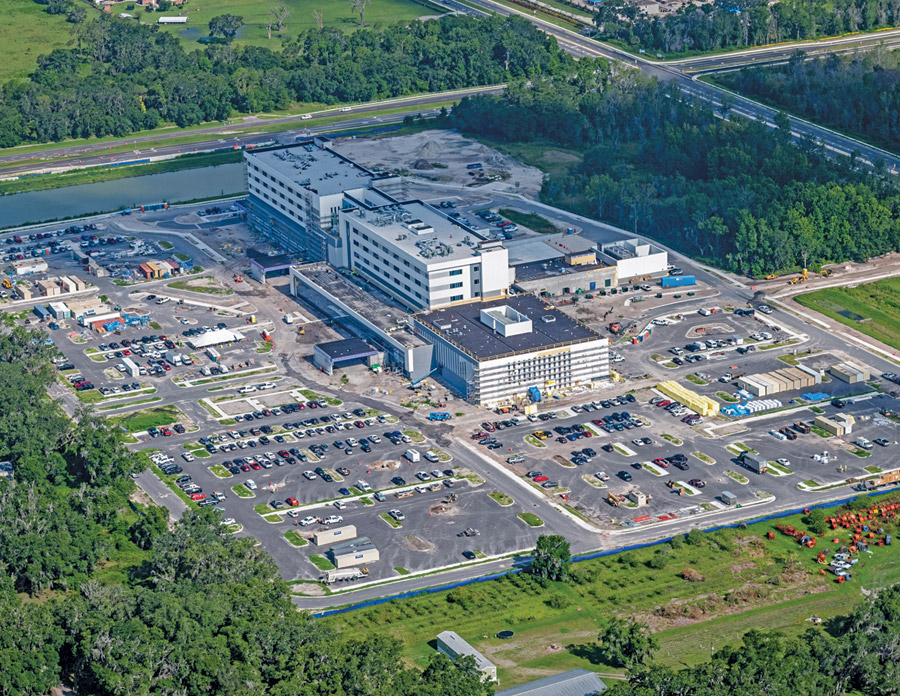“We’re in the best position we’ve ever been,” Barton Malow Builders’ COO Todd Ketola says of the company’s standing in the Southeast construction market. And judging by Barton Malow’s 2022 performance in the region, that sentiment seems well justified.
According to data submitted to ENR, Barton Malow recorded more than $720 million in regional revenue last year, nearly triple 2021’s performance. Those results contributed to the Southfield, Mich.-based parent company, Barton Malow Holdings, being ranked No. 25 on ENR’s Top Contractors list, with nearly $4.8 billion in domestic revenue.
“The pandemic accelerated migration to the Southeast, and it shows no sign of slowing down,” Ketola explains. “We’re well positioned to take on immediate growth in health care, K-12 and higher education and infrastructure.”
Having a decades-long presence and diverse capabilities in one of the nation’s consistently strong construction markets certainly helped fuel Barton Malow’s Southeast success last year. But Ketola says the path toward those results actually began in 2020 with implementation of a company-wide strategy focused on geographic expansion and market growth coupled with performance expectations based on a de-siloed “one-company” approach.
Along with the jump in regional revenue, Ketola adds that Barton Malow’s strategy has resulted in “a robust backlog with impact clients for future years.” That, in turn, has created a new challenge for the firm’s Southeast regional leaders—balancing responsible revenue growth with available resources.
“We’ve never been in the position where we had to say no more than yes on opportunities,” he says.

Barton Malow served as design-build leader for the award-winning and immersive Peppa Pig Theme Park in Florida.
Photo courtesy Legoland Florida Resort
Southeast Hot Spots
One of the markets Barton Malow has targeted is Tampa, where the firm opened a new office in December after a decade of managing projects in the area from its Orlando regional base. Among the current projects in the area is BayCare South Florida Baptist Hospital’s six-story, 150-bed, full-service replacement hospital and medical office building located just east of Tampa in fast-growing Plant City.
Nashville, another of Barton Malow’s regional anchors, is experiencing “exponential growth,” according to Chuck Binkowski, executive vice president and COO of Barton Malow Holdings. While that office was established about 10 years ago in part to support the manufacturing operations of longtime client General Motors in nearby Spring Hill, Binkowski says Barton Malow has taken a unique approach to diversifying its portfolio in recent years. Rather than jump into what was then Nashville’s hot multifamily market, Binkowski says the firm has instead cast a wider net in sectors that offered opportunities for sustained growth.
“Our intent was to expand beyond core clients and find ways to apply our experience in health care, sports facilities and other areas,” Binkowski explains.
One example is Barton Malow’s extensive experience in college and professional athletic facilities. The firm was recently tapped to renovate Simmons Bank Liberty Stadium in Memphis, a project that will receive part of a recently approved $350-million allocation from the Tennessee Legislature to upgrade the city’s sports facilities.
“Barton Malow works tirelessly to help us manage budget and expenses and provides all the facts we need to make decisions.”
—Ed Higgins, Associate Athletic Director, Vanderbilt University
Barton Malow also is serving as construction manager for Vanderbilt University’s master plan for athletics. Elements include incorporating a new practice and administrative facility for men’s and women’s basketball into the north end zone of the school’s football stadium and adding new seating and other amenities to the south end zone. McGugin Center, the centerpiece of Vanderbilt athletics, will also undergo a makeover with new training rooms, a sports medicine center and a sports performance center. New facilities for football and tennis are also planned.
Ed Higgins, Vanderbilt’s associate athletic director for capital projects says big-time college sports programs are no different from other owners when it comes to getting the most value out of their investment in new facilities.
“Barton Malow works tirelessly to help us manage budget and expenses and provides all the facts we need to make decisions,” he says. “They’re being good stewards of our money and time.”
The firm is also helping Vanderbilt manage the sometimes tricky logistics of having sports activities and construction safely coexist in a space-constrained environment. Those skills will be put to the test this fall when Vanderbilt’s always well-attended football games take place in a stadium with construction projects underway on two sides.
“That will challenge every aspect of our game day operations, but they’re helping us brainstorm ideas to make it all work with minimal disruption,” Higgins says. “It’s all part of their never say no, we’ll get it done attitude.”
Joanna McKenney, an associate with Jenkins Peer Architects who worked with Barton Malow on the $32-million renovation of Charlotte’s historic American Legion Memorial Stadium, likewise credits the firm for bringing not only a full understanding of such projects, but also an eye for details that tie such facilities to the community. During the dismantling of the Depression-era stadium’s stone field wall, for example, Barton Malow scanned the distinctive period lettering and replicated it on the new structure. Distinctive elements of the original art deco architecture were also carefully preserved.
“People grew up going to that stadium and had heartfelt memories of being there—and here it was, all brand new again,” McKenney says, adding that the Barton Malow team “was very collaborative from start to finish and willing to go the extra mile to make the renovation a success.”

In Nashville, Barton Malow is serving as construction manager for Vanderbilt University’s wide-ranging athletics master plan.
Photo courtesy Vanderbilt University
Tracking Trends
Even with its enviable financial performance over the past few years, Barton Malow has not been immune from the challenge of finding ways to combat supply chain disruptions and expedite construction while still providing owners as much cost and schedule certainty as possible—not an easy task in a fast-growing region where speed to market has become a top priority.
“They want it yesterday,” Binkowski says of clients’ expectations.
Appropriately, Barton Malow has strived to advance its project planning processes through a broader approach that includes extensive tracking of construction commodities, identifying essential lead times for prefabrication work, maximizing its use of BIM, drones and other technologies and earlier engagement with project team members.
“By us communicating as early and as clear as possible, our client and design partners can react to what we can and cannot do in more expeditious fashion,” Binkowski says. “That gives them enough time to rethink an approach or specify an alternative item that’s more readily available.”
An example of how these planning essentials came together is a 3.2-million-sq-ft electric vehicle battery manufacturing plant that Barton Malow is wrapping up in Spring Hill for Ultium Cells, a joint venture between GM and LG Energy Solutions. Using integrated project delivery, the project team successfully managed both internal and external complexities to meet the $2.3-billion project’s demanding 18-month schedule. Barton Malow is self-performing approximately 40-45% of the project, including layout, civil, concrete and steel erection work as well as interior finishes.

Barton Malow has targeted Tampa as a market of growth. The firm’s projects there include the six-story BayCare South Florida Hospital.
“To be able to put it together in a project that fast and of that magnitude took some real discipline on our part,” Binkowski says.
The Ultium project also highlights Barton Malow’s increasing role in helping trade partners and subcontractors raise the bar of safety awareness among a workforce that, due to pervasive labor shortages, is less experienced than in the past. Even with a peak worksite population of more than 1,200 tradespeople, the project enjoyed a remarkable safety record. With more than 3 million man-hours worked as of May 31, the project has recorded only a single lost-time injury.
Ketola adds that safety performance metrics across Barton Malow’s other projects indicate that its “relentless and intentional” focus on promoting safety is paying off.
“We have all kinds of safety training tools, but the biggest thing is changing the culture on the jobsite,” he says. “It takes a lot of communication, a lot of transparency and a lot of work to maintain a constant focus on doing the right thing.”
While the next few years appear equally promising for Barton Malow’s Southeast operations, Ketola says preserving the balance that’s fueled its recent growth will be critical.
“The projects are getting bigger, and the discipline needed to stay within our business model will be key.”
—Todd Ketola, COO, Barton Malow
“The projects are getting bigger, and the discipline needed to stay within our business model will be key,” he says, “but it’s absolutely exciting and encouraging where those markets are going.”
To help build management expertise for these and other assignments, Barton Malow will rely on multifaceted internal training efforts such as Lean University, which enhances project team members’ understanding and application of lean construction principles and practices. A planning rotation program cross-trains rising project delivery leaders across a variety of essential management disciplines while also providing opportunities to practice teamwork, relationship building, engagement and independent thinking.
And for those yet to enter the industry, Barton Malow’s college internship program, called LEAPS, provides real-life construction experience alongside targeted learning opportunities.
Indeed, the only factor that could limit the pace of growth in the Southeast is the pervasive shortage of trade labor, Ketola says. “We’re watching and managing ourselves, but we also need to manage our subcontractors to make sure they don’t take on too much.”
Binkowski agrees. “We need to be opportunistic but also stay in our lane and support projects we’re best suited to do,” he says. “The opportunities are going to be there.”




Post a comment to this article
Report Abusive Comment